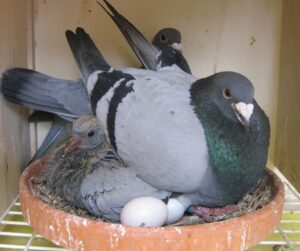I’ve always practiced pigeon sport guided by my own vision and by science. That mindset has never let me down in over fifty years with pigeons. Of course, I’ll admit it, sometimes you forget a small detail, and the pigeons make sure you pay for it. But that’s exactly the beauty of this sport: you never stop learning. Those who learn from mistakes and make fewer of them over time, will eventually become winners.
Everyone knows: without breeding, there are no champions. But anyone who thinks breeding is as simple as “bird A × bird B = super bird C” is mistaken. Breeding is a blend of genetics, experience, dedication, and, yes, a touch of luck. And that’s exactly what makes it so fascinating.
Before you start pairing, have your birds checked by a pigeon-specialized Veterinarian. They must be healthy, free from infections and parasites, at proper weight, and in top condition.
A healthy start is half the victory.
Well ahead of the breeding season, focus on special nutrition and supplements such as omega 3-6-9 oils. These fats aid vitamin absorption (A, D, E, K), boost the immune system, and may even help produce sharper, quicker-learning youngsters.
Personally, I use an omega mix of fish oil, linseed oil, and sheep fat before pairing. The birds look livelier, fertility rates increase noticeably, and the youngsters develop far better.
Timing & Preparation, Why I Start in November.
In Western Europe, many fanciers pair as early as November. Youngsters bred early in the season are older, stronger, and better prepared when the young bird races begin. Nature speeds up, so we must follow.
For marathon enthusiasts it’s different: they often prefer later breeding to avoid early moulting.
Start increasing day length gradually, longer days, shorter nights, and adjust the feed accordingly. Use a quality breeding mix so your pairs enter the season in perfect condition.
Compensation Breeding
I’ve experimented with pairing larger cocks to smaller hens to avoid producing oversized or heavy youngsters. The results were impressive,offspring combining power with elegance without losing balance. That harmony showed clearly in their race performance.
Pairing Strategy, Stick or Switch?
In breeding, everything revolves around balance. Some fanciers stay loyal to a proven pair,“if it works, don’t change it.” Others prefer experimenting, pairing strong pigeons with new partners to add fresh qualities. Both paths can lead to success, as long as the birds match in type and distance.
You can safely cross an inbred line A with an inbred line B, provided they’re suited for the same distance, sprint, middle distance, or marathon. That way you reinforce what works without losing the vitality every champion needs.
And yes, I’m no stranger to that approach myself, sometimes two top pigeons click so perfectly that one of their youngsters suddenly exceeds every expectation.
Genetics & DNA, Good × Good = Better Chances of Top Performers
 Breeding is far from simple arithmetic, genetics is the main player. Laboratories can analyse Quality genes such as LDHA, DRD4, and CRY1, which are linked to stamina, speed, and orientation. I test almost all my pigeons for these markers and for quality gene (Q-gene) research, working for several years now with PiGen (Dr. Ruben Lanckriet & Pascal Lanneau).
Breeding is far from simple arithmetic, genetics is the main player. Laboratories can analyse Quality genes such as LDHA, DRD4, and CRY1, which are linked to stamina, speed, and orientation. I test almost all my pigeons for these markers and for quality gene (Q-gene) research, working for several years now with PiGen (Dr. Ruben Lanckriet & Pascal Lanneau).
Practical takeaways:
Good × good increases the odds of excellence.
Linebreeding fixes strong traits.
Crossbreeding adds vitality (heterosis) and fresh blood.
And never overlook the dam line, it’s often where true stability lies.
The Underrated Factor, The Mother Line
Many fanciers love to talk about the fathers, the big winners, the “foundation cocks,” the heroes of catalogues. But I’ve learned that real strength often lies in the mother line.
Take my own family: Lady Richelle (the grandmother), Orange Oil (the mother), Goldplay (the daughter), and Lady in the Dark. Lady Richelle herself never raced, but as a mother and grandmother she’s behind countless national and international TOP performers. Her stability passed on quality and calmness.
It’s a bit like in life, fathers get the credit, but the mothers quietly do the real work.
(And yes, I say that mainly to stay on good terms with my wife!)
The Q-Genes, Science at Full Speed
The latest step in pigeon genetics is the study of quality genes (Q-genes). Research by PiGen and other labs has shown that certain gene variants, such as LDHA-AA or DRD4-CTCT, appear more frequently in top-performing pigeons.
An example of a particularly favourable genetic profile might be: CTCT – AA – TTTT – AA – TT – HH.
It’s not a magic formula, but it helps make smarter pairing decisions. Science is catching up with the sport and that’s progress I can only applaud.
Raising the Young, Nutrition & Care in the Nest
Provide a balanced breeding mix, rich in proteins and sulphur amino acids like methionine for feather development. Add enough calcium and phosphorus for bone strength. Omega 3-6-9 oils support cell growth and brain development.
And ensure fresh air, natural light, and calm loft conditions so youngsters can grow, not just survive.
In Conclusion
Breeding is no exact science; it’s a blend of technique, knowledge, and a touch of magic. You can plan, guide, and analyse, but pigeons will always surprise you.
Whether you’re a beginner or a seasoned fancier: start healthy, feed smart, breed with intent. Because those who start well, often finish as winners.
Best of luck, and enjoy your breeding season!
Until the next blog.
Gerard Schalkwijk









Excellent Tips on breeding and pairing of birds genetically.
I just paired my birds and used genetic pairing.
Thanks Raymond!